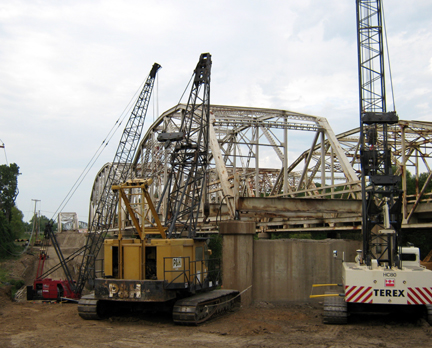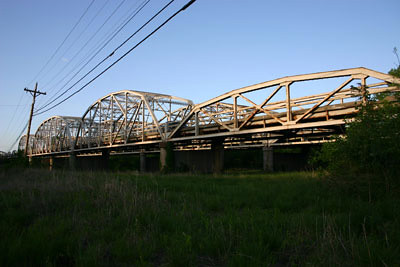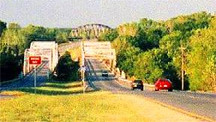
Big machines are tearing down the historic Bird Creek Bridge that carried U.S. Highway 66 near Catoosa, Okla. A more nondescript bridge will replace the deteriorated but distinctive 1936 truss bridge. Soon, one-half of the scenic Twin Bridges vista will be gone forever.
It didn’t have to be this way. A report by two engineers and an bridge architect said the Bird Creek Bridge could have been saved if the Oklahoma Department of Transportation had made “a real effort” to maintain it during the past decade.
Also, records show ODOT did not inspect the bridge in 2008, as recommended. By the time the bridge was inspected again in 2009, its decking was downgraded to “serious” in the condition report, and the cost of making improvements rose by more than $3 million.
At an ODOT hearing in Catoosa in April 2010, state transportation officials made it clear the Bird Creek Bridge, listed on the National Register of Historic Places, would have to be replaced, and soon. They said the 75-year-old bridge had outlived its expected age. Its concrete deck was crumbling. Its steel trusses were rusting away.

But a report to the Oklahoma Route 66 Association in January 2011 pins the blame for the bridge’s poor condition on ODOT’s lack of maintenance. Association President Mike Hickey, architect Jack Bedingfield, structural engineer Rubin Millerburg, and structural engineer and bridge designer Don Wickens toured and examined several bridges along Route 66 in northeast Oklahoma. In their report, they said this about the Bird Creek Bridge:
‘This is a mixed truss structure deemed in good condition as recent as 2002 […] It is the opinion of this team that if a real effort had been made to properly maintain this structure during the passed (sic) nine years it could have been saved as part of the heritage and history of Route 66.”
Citing the Oklahoma Open Records Act, I requested five years of records from ODOT concerning the Bird Creek Bridge. A few of the findings:
— The Bird Creek Bridge had been inspected by the Burgess & Niple engineering firm in 2006, 2007, 2009, and twice in 2010. But records show that no inspection was performed in 2008. The Bird Creek Bridge went from April 2007 to July 2009 without a professional inspection.
In the 2007 inspection report, the bridge’s deck was graded a 4 (poor), its sufficiency rating was 39.5, and the cost of recommended improvements was $5.09 million, the same as in 2006. The report recommended the next inspection for April 2008, but that apparently never happened.
Twenty-seven months later, the 2009 inspection revealed that the bridge’s deck had been downgraded to a 3 (serious), its sufficiency rating had dropped to 23.5, and the cost of recommended improvements had jumped to $8.16 million. The bridge had obviously shown severe degradation in that two-year period.
By July 2010, the bridge’s sufficiency rating had dwindled to 2.0.
Emails to ODOT, asking why no inspection occurred in 2008, were not answered. An email to Burgess & Niple asking the same question was deferred to ODOT.
— Several people from the Route 66 community suggested the steel trusses from the Bird Creek Bridge be reused on the new bridge. An ODOT official rejected that idea because of wind sheer and other structural problems with the old trusses.
One of Burgess & Niple’s more-detailed inspection reports in 2009 shed light on why recycling the trusses wasn’t possible: almost all of the spans were compromised by rust or cracks.

One page from the inspection report (shown above) illustrates the extensive problems. Lines in red indicate “fracture critical” parts that needed repairs. Such damage in the trusses was frequently cited in the report.
The number of cited problems with the trusses increased from 15, in the 2009 report, to 29 in 2010.
At least two of the smaller pony trusses will be used at a park entrance near the bridge, but only after repairs are made.
So why was maintenance on Bird Creek Bridge poor? According to engineers at an ODOT public hearing in January 2011, their agency had been “reactive, not preventative” because state funding for roads and bridges had remained flat from 1985 to 2005. In other words, ODOT says it didn’t perform maintenance because of a lack of money.
To ODOT’s defense, pages 50 and 51 of this document support its contention that the state stiffed them on funding as the years progressed. It shows state appropriations for roads and bridges remaining about the same each year (around $200 million) while inflation during that 20-year period totaled more than 75 percent.
However, “Oklahoma Route 66” author and historian Jim Ross said there also seems to be a mind-set by ODOT and other highway agencies to replace old bridges, instead of maintaining them. Ross said in an email:
The most interesting thing I have found about Route 66 bridges as well as other historic bridges is that once a bridge reaches a certain age, and / or as funding becomes available, plans are enacted to replace it. […T]here seems to never be money for maintenance, but always money for replacement, including substantial amounts for demolition — money that could be used instead toward keeping the existing bridge in place or moving it.
Because of that “replace, don’t repair” tunnel vision, ODOT received criticism from the Route 66 community and the Oklahoma Historical Society when it set its sights on condemning and replacing the Bird Creek Bridge.
“There was absolutely no consideration of the bridge’s historic value,” Hickey, the Oklahoma Route 66 Association president, said of ODOT’s decisions.
After the outcry, ODOT entered into a 10-year memorandum of agreement (MOA) with the state historical society. The highway department must produce a documentary about Bird Creek Bridge, plus preserve a section of pony trusses for the Catoosa park. ODOT must also give the adjacent 1957 eastbound bridge a new paint job and other repairs by 2015.

They key part of the deal is ODOT must draft within 18 months a management plan “for highway improvement projects along the Route 66 corridor.” That includes bridges. The MOA was finalized in March, so ODOT must submit its Route 66 plan to the historical society by September 2012.
It is hoped the final part of the MOA contains strict measures to preserve Route 66 bridges, especially the 1933 Pony Bridge near Bridgeport. And preserving old bridges can be done, as this document by the American Association of State Highway and Transportation Officials shows. Case studies include steel truss bridges that are more than a century old.
If it sounds like I’m urging special treatment for Route 66 bridges, so be it. Route 66 remains the most famous road in the world, and it attracts tens of thousands of visitors from dozens of countries each year. What other road in Oklahoma does that? The Mother Road deserves special treatment.
If the management plan needs funding, some federal grants will be available through the Federal Highway Administration, America’s Byways, and other programs. Or perhaps a half-cent diesel tax could pay for it. Oklahoma has among the lowest diesel taxes in the nation — and some of its worst roads and bridges.
In the meantime, Oklahoma City on Oct. 11 will commemorate the reopening of the historic Lake Overholser Bridge. The city replaced the deck and made other repairs to the the 1924 bridge. It soon will carry traffic again, and should for many more years.
Hickey, acting in his duties as Oklahoma Route 66 Association president, will invite ODOT officials to a ceremony that celebrates the preservation of one of the Mother Road’s most historic bridges.
I wonder whether they’ll come?
UPDATE: David Streb at ODOT replied with an email Friday, a few hours after this post was published. He confirmed the agency did not have a professional inspection done on the Bird Creek Bridge in 2008, but said the agency’s maintenance staff in Rogers County made “routine” checks on the bridge. Streb did not provide dates of when these checks were made.
As for the agency being “reactive, not preventative” in terms of bridge maintenance, Streb said:
The comment on ODOT engineers being reactive and not proactive due to lack of funding from 1985 to 2005 is indeed accurate. In fact the DOT state funding was flat for those 20 years. The analogy would be that you wouldn’t be painting your house and caulking windows if your roof leaked. ODOT only had funds to deal with the most critical needs. However, since 2006, the state legislature has increased their commitment to transportation and the Department is now able to schedule more asset preservation projects on bridges to extend their life. While the bridge problem in Oklahoma is still critical it is becoming more manageable with this increase in state funding. It is important to again state as I did above, that a number of factors contributed to the deterioration of this particular bridge.
For the record, I emailed the questions on Aug. 7 and requested a reply by Aug. 15. I emailed similar questions to ODOT on April 30 and received no answer, other than an acknowledgement that the questions would be forwarded to the correct department for reply.


Nice bit of reporting there, Mr. Bernst… er, Warnick.
Sad, it was one of the coolest bridges on Route 66 and wont look right without both of them side by side,
Okay, I stand corrected since my last comments regarding ODOT’s involvement with Route 66. This really sucks. I saw the initial work taking place in November of last year, and was still able to drive it. I thought at the time they were going to replace the deck. Its too bad. I agree with Jim Ross on this one 100%. Why is there not enough money to maintain, but always enough to demolish and rebuild???? Its senseless they way our government uses our money. Hopefully this will raise enough awareness to save the adjacent structure. It bears resemblance to the older bridge at least.
First, this bridge is not over bird creek! Its over the old channel of the Verdigris River. Bird Creek never crosses RT.66 Why has nobody else ever brought this up? Bird creek dumps into the river about a mile west of RT66.
Second, Odot sucks, they say they couldnt reuse the old trusses to maintain the look of the old bridge because of wind sheer? What a load of cripe!
They didnt have to use the old trusses as part of the load bearing structure of the new bridge! They could have simply just have them in place for looks.
It makes me sick every day i drive thru there.
Doug, that part of the river was renamed Bird Creek. That’s been reported consistently in numerous reference books.
If one looks at Google Maps, that is the old channel of the Verdigris River. In fact, the map labels it as such. Bird Creek used to empty into the Verdigris River just upstream of this bridge. However, when the Port of Catoosa was built, Bird Creek was diverted to the north to empty into the Verdigris just south of the port. The Verdigris channel that passes under this bridge now is severed to the north by the Burlington Northern Railroad, so there are two “dead end” channels so to speak – one that makes an oxbow to the north and is called “Bird Creek” (the old Bird Creek and Verdigris River channels), and the one to the south that is called the Verdgris River (and passes under these bridge)s. In fact, Spunky Creek now empties into the “south” channel, so the main water flow in this channel comes from Spunky Creek.